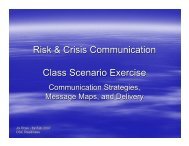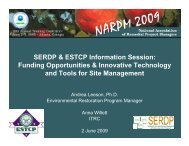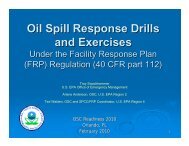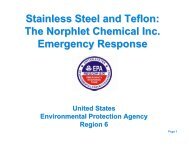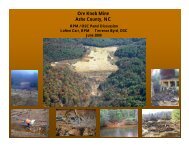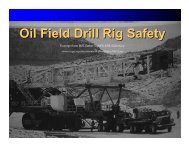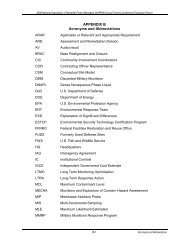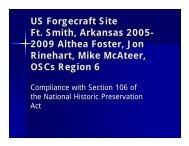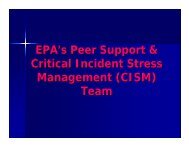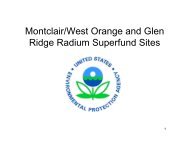OSC 2007 Evaluation Report
OSC 2007 Evaluation Report
OSC 2007 Evaluation Report
Create successful ePaper yourself
Turn your PDF publications into a flip-book with our unique Google optimized e-Paper software.
<strong>2007</strong> <strong>OSC</strong> Readiness Training Program <strong>Evaluation</strong> <strong>Report</strong><br />
complete in a single week at a single location; achieve inter-regional networking among <strong>OSC</strong>s; and<br />
showcase regional case studies, current tools, and resources available to <strong>OSC</strong>s.<br />
Overview of Activities<br />
Plenary sessions at the Annual Readiness Training Programs complement the in-depth training that occurs<br />
during the technical courses. The plenary sessions are a forum that presents information about new<br />
policies and guidance relevant to EPA’s National Approach to Response, as well as details about national<br />
and local initiatives. The sessions also are intended to maintain communication between the regions and<br />
EPA’s Headquarters. Daily plenary sessions were held each morning of the <strong>2007</strong> <strong>OSC</strong> Readiness<br />
Training Program. Some of the topics addressed during the week include the <strong>OSC</strong>’s role in response,<br />
homeland security, the role of the RSC, protecting the nation’s water infrastructure, Hot Sites, and the<br />
removal manager report.<br />
Thirty-six training courses covering technical, legal, and administrative topics were offered at this year’s<br />
Annual Training Program. The training methodologies used in the courses were varied and included case<br />
studies, lectures, Web-based training, and discussion. Some of courses offered included Advanced<br />
Hazard Identification and Categorization, Assessing Vapor Intrusion from Ground Water and Soil to<br />
Indoor Air, Avian Influenza, Case Studies, Daily Implementation of the Incident Command System<br />
(ICS), Environmental Support Function (ESF)-10 — From No Mission to Mission, How to Be Nice and<br />
Play Well with Others in the Contracts Environment, Knowing and Using the National Contingency Plan,<br />
New and Improved . . . the 2006 SPCC Rule Amendments, People, Relationships, and Interaction within<br />
Incident Management, Potentially Responsible Party (PRP) Response Workshop, Risk and Crisis<br />
Communication, The Rapid Assessment Tools (RAT), Water System Response, and You Mean There is<br />
more than Superfund ... ? Basics of Environmental Statutes. Descriptions of all the courses and copies of<br />
the course materials are provided on the <strong>OSC</strong> Readiness Training Program Web site at<br />
http://www.oscreadiness.org/<strong>2007</strong>/.<br />
Working luncheons for participants at the <strong>OSC</strong> Training Program were sponsored on Monday, February<br />
12, and Wednesday, February 14. These meetings updated participants on homeland security issues that<br />
face EPA and presented issues that confront responders.<br />
The Tech Zone, available Monday through Thursday, featured 26 exhibits, demonstrations, and<br />
informational booths that showcased information of interest to <strong>OSC</strong>s. The Tech Zone provided an<br />
opportunity for participants to network and learn about new initiatives and resources available to assist<br />
them with their jobs. Descriptions of the Tech Zone exhibits are available on the <strong>OSC</strong> Readiness<br />
Training Program Web site at http://www.oscreadiness.org/<strong>2007</strong>/.<br />
Several after-hour activities were planned during the week to bring participants together in informal<br />
settings. Activities included a welcome reception sponsored by the Deauville Beach Resort on Monday<br />
night and the “Gumbo Fest” on Thursday night.<br />
Participants<br />
The more than 446 2 participants at the <strong>2007</strong> <strong>OSC</strong> Readiness Training Program included <strong>OSC</strong>s, RSC staff,<br />
EPA regional removal and emergency response support staff, branch chiefs, CICs, RPMs, regional<br />
attorneys, members of the ERT, and 16 representatives from other federal agencies. These additional<br />
agencies included the U.S. Coast Guard, Tennessee Valley Authority, Occupational Safety and Health<br />
Administration, U.S. Department of Agriculture’s U.S. Forest Service, U.S. Department of the Interior’s<br />
National Park Service and U.S. Fish and Wildlife, Agency for Toxic Substances and Disease Registry,<br />
2 Consultants who helped facilitate the training program are not included in this number.<br />
ES-2



